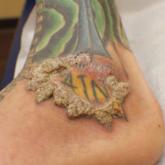Article

Verruciform Plaques Within a Tattoo of an HIV-Positive Patient
- Author:
- Jarad Levin, MD
- Thomas Stasko, MD
- Daniel Tinker, MD
- Katelin Harrell, MD
- Henry Haskell, MD
A 40-year-old man with a medical history of human immunodeficiency virus infection managed with highly active antiretroviral therapy, psoriasis,...
